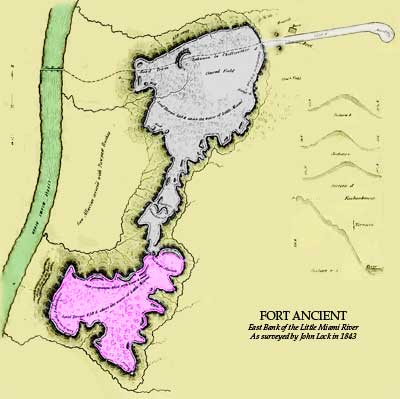
The Fort Ancient Museum was accredited by the American Association of Museums.
Fort Ancient
Overlooking the Little Miami River, Fort Ancient was built over 2,000 years ago. Fort Ancient features 18,000' of earthen walls built by Ancient Ohioan Natives. Over the years, it is believed the site has been occupied by a number of different cultures that have come and gone. The designation as a fort is not necessarily correct, but given its position on top of a hill, it is hard to imagine that it wasn't created for some type of defensive position. On one side of the site and 240' below is the Little Miami River.

One of 2 conical mounds near the OHS entrance.
Some features of the site have disappeared due to extensive farming and erosion since they were surveyed in the early 1800s. As you approach the Ohio Historical Site from the east on SR350, you'll see 2 large conical mounds on either side of the highway just before the official entrance to the museum. Unlike many conical mounds found in Ohio, these two mounds contained no artifacts or remains. Archeological studies are ongoing at this massive site and new features are continually being discovered that are throwing new light on the significance of this ancient site.
 It is thought that the earthen walls, some as high as 23 feet, when originally constructed were built by using the shoulder blades of deer and elk antlers, clam shell hoes and digging sticks. The loosened soil was then most likely carried in woven baskets that could hold about 35 to 40 pounds.
It is thought that the earthen walls, some as high as 23 feet, when originally constructed were built by using the shoulder blades of deer and elk antlers, clam shell hoes and digging sticks. The loosened soil was then most likely carried in woven baskets that could hold about 35 to 40 pounds.
Some have suggested that the 67 openings in the 3 plus mile length of wall were used as astronomical alignment guides to coincide with the rising and setting of the sun and moon at their most northern positions similar to Stonehenge.
The problem with these theories are that there are similar gateways found on the due south and north sides of the enclosure. The sun or moon never rises / sets directly south or north in Ohio.
However, when you visit the site, you can see for yourself that this was not some astrological observatory constructed so that they could tell what time of year it was. The site has an extremely strong defensive position designed to repel enemy attacks. Everything about the earthen and stone walls were meant to repel attackers. Even the strategically placed gateways were designed to funnel attackers in through a specific points where they can be easier to defend.

Evidence suggests that this imposing site has been occupied by successive cultures dating back to around 100 B.C. The original enclosure (indicated in pink in the above map). This was later expanded. Although Fort Ancient is the largest defensive earthwork in North America, it was certainly not the only such site, especially found here in Ohio. Numerous ancient defensive sites have been identified in southern Ohio.
The Fort Ancient culture thrived in southern Ohio and northern Kentucky. Numerous villages were located throughout the area and were made up of a number of circular or rectangular houses surrounding an open plaza. The Fort Ancient people continued building small burial mounds, but gradually shifted to burials in a cemetery area with no mounds. There is some evidence suggesting that the Fort Ancient culture also built Serpent Mound in Adams County.
Fort Ancient is distinguished from other sites primarily by its style of pottery, but also by their small triangular arrow points as well as distinctive shouldered pentagonal flint knives.
 Other artifacts recovered from archeological excavations include shell hoes, gorgets (a shell that has been worked to be used as a medallion hung from the neck-- see image at left), and other ornamentation, bowl stone pipes and elbow stone pipes, and stone discoidals, or stone discs believed to have been used in certain games.
Other artifacts recovered from archeological excavations include shell hoes, gorgets (a shell that has been worked to be used as a medallion hung from the neck-- see image at left), and other ornamentation, bowl stone pipes and elbow stone pipes, and stone discoidals, or stone discs believed to have been used in certain games.
Many bone tools are also evident such as deer and elk scapula hoes and awls, punches and fish hooks. During the 9th and 10th centuries the Fort Ancient culture had become increasingly dependent upon agriculture as a subsistence base, though floral and faunal evidence hunting and gathering continued to play a large role in subsistence.
Why these ancient Ohioans left perhaps will never be known for certain. What we do know is that they stopped building earthworks around 1400 AD. Centuries of farming in rural areas and development of large cities and their suburbs have probably destroyed any remaining evidence to fill in the gaps between the ancients and the historic Native Americans that settlers came in contact with in the 1700s. Most of the historic Native Americans living in Ohio at that time came from other areas and migrated into Ohio.

Some theories suggest that early European explorers may have carried diseases that killed these ancient Ohioans. While it is true that Europeans introduced new diseases to the continent with devastating results, the archeology suggests that the Ancient Cultures were already long gone.
Perhaps it was a change in climate or meteorological events. For example, we hear news items today about extensive flooding and saying that flooding is a 100 year flood, or even a 500 year flood meaning that such flooding only occurs every 500 years or so. Since the Ancient Cultures were extensively agricultural cultures, that meant that during the summer months they would be tending crops in the rich flood plains of the major rivers, like the Scioto and Miami. When you travel through these areas you'll notice the wide level planes that exist between the hills. It is possible, and highly likely, that at some time during our past, that these plains flooded, perhaps in a 1000 year flood. Not only would this massive flood caused the death of most of the inhabitants, it would have also washed away all surface structures except those buried inside the mounds. This of course is just conjecture.



Life-sized display help illustrate day-to-day life of Native Americans
For Ancient Museum
The Museum at Fort Ancient contains 9000 sq. ft. of exhibits, including many interactive units, focusing on 15,000 years of American Indian history in the Ohio Valley. The Museum also contains a classroom, a research area, and a sales shop with many fine American Indian items.
In 2011 the museum was accredited by the American Association of Museums. To achieve this accreditation requires a lengthy process. Less than 5% of the nation's museums have achieved this status.
Hiking Trails
There are numerous hiking and interpretative trails at Fort Ancient plus the Little Miami Scenic Trail in the valley. There are picnic facilities and bathrooms. It is forbidden to walk off the established trails or walk on any mound or earthwork. This is an archeological site.
Fort Ancient Celebrations
The Fort Ancient Celebration began in 1990 to educate the public about Native American heritage. One weekend in early June, the public will have the opportunity to listen to storytelling, flute music, discussion of early settlement and trade, or the early history of the Ohio area through the eyes of descendants from the historical Native Americans.
Visitors can participate in dancing and drumming that has become one of the main attractions for the weekend event. Craft demonstrations including bow making, pottery making, finger weaving, glass bead making, dream catcher manufacturing, and herb lectures. Hands on activities include archery, spear and tomahawk throwing, pump drilling and other workshops.

View from an observation platform in the southern end of Fort Ancient. This view is looking northwest over the Miami River valley. The bridge in background is I-71.
Was Fort Ancient a Fort?
The reason given by most archeologists against the idea that this was not a fortification is the fact that there are a large number of gaps in the walls that would allow for easy access by enemy forces. However, these actually seem to be choke points, that would direct foes into pre-determined points of entry. Instead of having to defend the entire 3+ miles of walls, the could concentrate their defenses on just these entry points. As an enemy advanced on the hill top, they would not know that the walls were even in place because the walls would look no different than the rest of terrain. What they would see as they struggled up the steep cliffs were the the low points in the terrain (the gaps in the wall) and would advance towards them. I believe the defenders would be keenly aware of where they would be advancing and set up kill-zones in these areas.

Fort Ancient Location
Fort Ancient is 7 miles southeast of Lebanon, in Warren County, on SR 350. Exit I-71 at Wilmington Road (exit 36) and take Middleboro Road south to State Route 350, turn right to the park.
Fort Ancient
6123 SR 350
Oregonia, Ohio 45054


